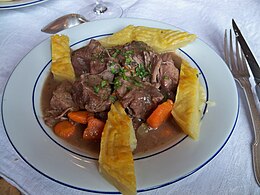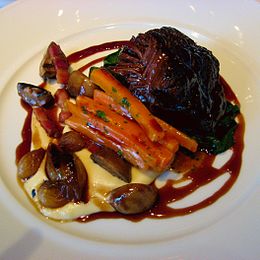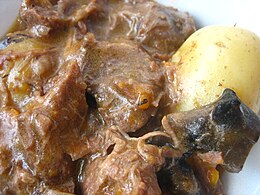Daube
This article needs additional citations for verification. (June 2011) |
 | |
| Type | Stew |
|---|---|
| Place of origin | France |
| Region or state | Provence |
| Main ingredients | Beef, wine, vegetables, garlic, herbes de Provence |
Daube is a classic Provençal (or more broadly, French[1]) stew made with inexpensive beef braised[2] in wine, vegetables, garlic, and herbes de Provence, and traditionally cooked in a daubière,[1] a braising pan.[3] A traditional daubière is a terracotta pot that resembles a pitcher, with a concave lid. Water is poured on the lid, which condenses the moisture inside, allowing for the long cooking required to tenderize lesser cuts of meat. The meat used in daube is cut from the shoulder and back of the bull,[citation needed] though some suggest they should be made from three cuts of meat: the "gelatinous shin for body, short ribs for flavor, and chuck for firmness."[1] Although most modern recipes call for red wine,[3] a minority call for white,[4] as do the earliest recorded daube recipes.[citation needed]
Daube is adapted in New Orleans cuisine to make daube glacé.
Variations also call for olives, prunes, and flavoring with duck fat, vinegar, brandy, lavender, nutmeg, cinnamon, cloves, juniper berries, or orange peel.[5][citation needed] For best flavor, it is cooked in several stages, and cooled for a day after each stage to allow the flavors to meld together. In the Camargue and Béarn area of France, bulls killed in bullfighting festivals are often used for daube.[citation needed]
Traditionally it should be cooked for a long time and prepared the night before it is served.[1][3] Daube with lamb is traditionally made with white wine.[citation needed]
Daubière

A daube is best made in a daubière. The shape of the pot makes sure condensation builds and no evaporation occurs, so everything stays moist.
- Examples of daube of beef
-
Daube of beef with lardons, carrots, and button mushrooms, served on parsnip puree
See also
References
- ^ a b c d e David Leite (November 30, 2009). "Paula Wolfert's Beef Daube is as Authentic as It Gets". Leite's Culinaria. Retrieved 2011-06-20.
- ^ "Daube". Merriam-Webster. Retrieved 2011-06-20.
- ^ a b c "Daube of beef". Boston.com. January 26, 2011. Retrieved 2011-06-20.
- ^ Montayne, P. New Larousse Gastronomique, Hamlyn London 1977, p106
- ^ New Larousse Gastronomique, op. cit.
External links
- "Daube de Boeuf". Saveur (#8). Archived from the original on 2008-03-29. Retrieved 2011-06-20.
{{cite journal}}: Unknown parameter|deadurl=ignored (|url-status=suggested) (help) - "Braising Makes a Tough Cut Tender". Science of Cooking. Exploratorium. Retrieved 2011-06-20.
Think carbonnade, pot roast, fricassee, stew, or daube. While all these dishes are variations on braising, most are more complex than those enjoyed by our ancestors.


